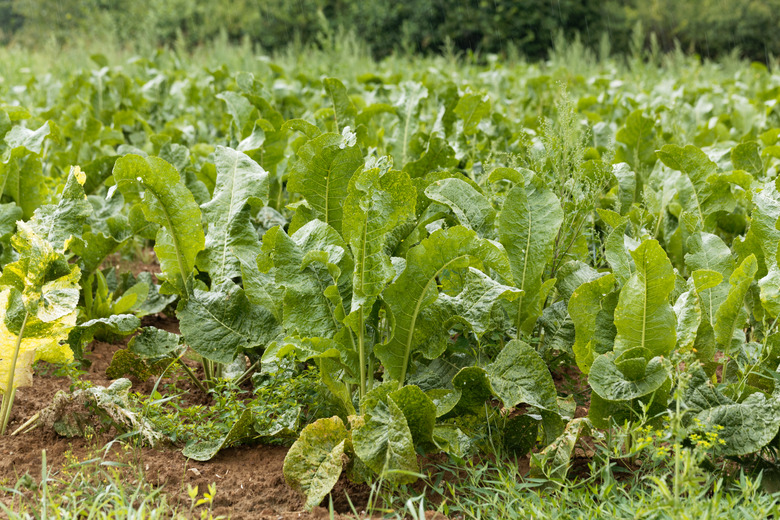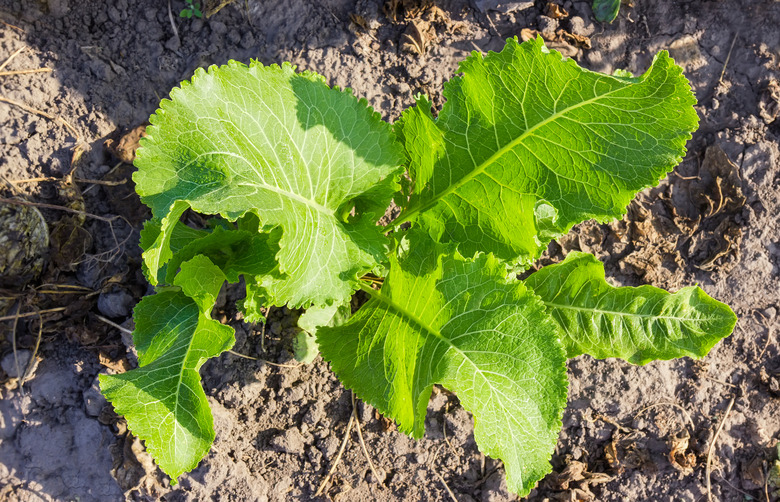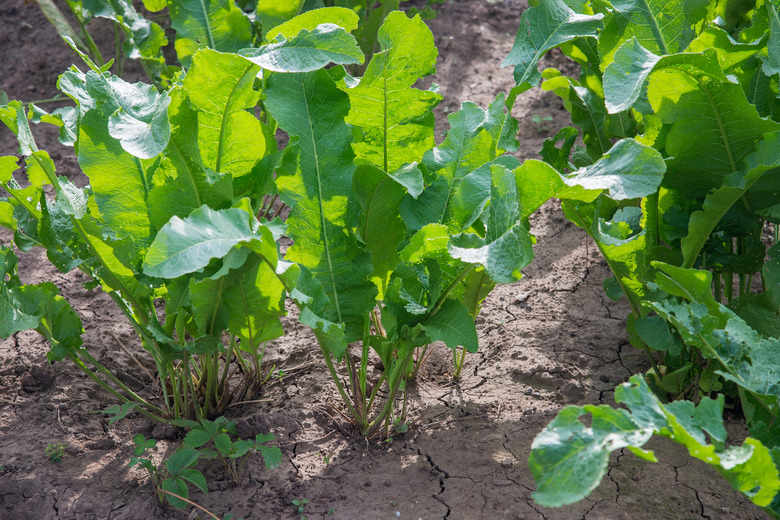How To Grow Horseradish
We may receive a commission on purchases made from links.
- Best uses for horseradish
- How to grow horseradish
- In what zone does horseradish grow best?
- When should you plant horseradish?
- Soil, sunlight and water recommendations for horseradish
- How to propagate horseradish
- How to winterize horseradish
- How to harvest horseradish
- Common pests and other problems for horseradish
- Common diseases for horseradish
If you've never tried horseradish (Armoracia rusticana) and are unfamiliar with its taste, think about the wasabi you used the last time you were in a sushi restaurant because it was probably horseradish. Wasabi is derived from a different plant that grows only in Japan, and it isn't abundant, so most of the wasabi used in North America is actually horseradish that has been dried, dyed green and reconstituted before being served. Horseradish is a fairly common condiment, however, so it's unlikely that you haven't tasted it, and what better way to appreciate its sinus-clearing spiciness than to grow your own?
Horseradish is usually propagated by root cuttings, which are a little hard to find at nurseries, so you may have to get them online. The plant grows aggressively enough to be invasive, and the edible, mustardy-green horseradish leaves can reach a height of 3 feet, which is tall enough to shade other plants in your vegetable garden, so you might want to consider growing it in a container. Horseradish plants grow a taproot that can be as long as 24 to 30 inches, so you need a deep container.
The horseradish plant is a hardy perennial plant that belongs to the mustard and cabbage family (Brassicaceae), but it's generally grown as an annual because the roots get tough and fibrous in the second year. It has a long growing season, and it takes 140 to 160 days for horseradish roots to mature, but the plant is cold hardy and can stay in the ground until late autumn. The roots may even benefit from some frost exposure, but keep in mind that roots left in the ground over winter will resprout in the spring.
Best Uses for Horseradish
Best Uses for Horseradish
Horseradish is native to Eastern Europe, coming to North America with the European settlers, and it has been used throughout history from the time of the Egyptians onward as a condiment and a medicine. The root is reported to help reduce pain when used topically; it's a diuretic and a cold remedy; and it clears congested sinuses. The compounds that produce all the fireworks — glucosinolates — can actually harm the plant itself, so they are activated only when the root is crushed, which releases an enzyme that does the job. The compounds quickly degrade, which is why it's important to preserve horseradish or, better yet, grow it yourself and eat it fresh.
Edible varieties of horseradish fall into two broad categories: common horseradish with large, crinkled leaves and superior-tasting roots and bohemian types with narrow, smooth leaves and lower-quality roots. Bohemian types have the advantage of being more resistant to white rust, a common ailment of horseradish plants. In addition, there's an ornamental cultivar known as 'Variegata' that isn't edible but its marbled white-and-cream leaves make attractive foundation plants or border plants.
Horseradish will grow from even a root fragment, which makes controlling it difficult. When you harvest the roots, it's important to dig all of them out, or the plant will appear again in the spring, perhaps as an unwanted guest. On the other hand, you may appreciate the large leaves, attractive white flowers and welcome volunteers. If you want to avoid having to dig through the garden to eliminate every tiny root fragment, however, you should plant horseradish in a container, which you can bury if you want.
How to Grow Horseradish
How to Grow Horseradish
- Common Name: Horseradish
- Botanical Name: Armoracia rusticana
- When to Plant: Four to six weeks before the last frost date
- USDA Zones: 4-8
- Sun Exposure: Full sun, partial shade
- Soil Type: Rich, loose, well-draining soil with a pH between 5.5 and 6.8
- When it's in Trouble: Root will split in rocky soil
- When it's Thriving: Verdant green leaves are tall, and root crown may be visible at ground level
Starting Horseradish From Seed
Horseradish is almost always grown from root cuttings, and you'll have a hard time finding commercial seeds if you can find them at all, but it doesn't hurt to know how to grow this pungent herb from seed if you happen to get lucky. When sowing seeds in containers, use deep containers because the roots need space to develop before transplanting.
Because of the long growing season and because horseradish is cold-hardy, you'll want to transplant in early spring, so when you are starting seeds indoors, sow them in January or February. Sow the seeds 1/4 to 1/2 inch deep in fertile and moist but well-draining soil. They germinate in about seven to 15 days, and you should thin them to be 8 inches apart when the seedlings develop leaves.
Starting Horseradish From a Seedling
You can set out transplants or plant cuttings when the average soil temperature is between 45 and 75 degrees Fahrenheit. If you're planting more than one, space them by 8 inches in rows that are 16 to 20 inches apart. Plant seedlings or root cuttings in shallow trenches about 3 to 4 inches deep and cover them with 2 to 3 inches of soil. If you don't plant in containers, surround the planting beds with buried wood, metal or concrete barriers to prevent the plants from taking over the rest of your garden.
In What Zone Does Horseradish Grow Best?
In What Zone Does Horseradish Grow Best?
Horseradish is a plant that likes it cold, and it thrives in Northern growing zones, as a perennial in USDA plant hardiness zones 4 through 8. It has a long growing season and needs a good five to six months to mature, and that's doable throughout most of its growing range. The root tastes best if left in the ground until late fall after the first frost, so growers in Northern regions are more likely to get better results than those on the southern edges of its growing range, where the ground doesn't freeze. Growers in Southern regions, however, have the option of planting in the fall to get a spring harvest.
When Should You Plant Horseradish?
When Should You Plant Horseradish?
In the North, horseradish root cuttings or crowns as well as transplants should be in the ground about four to six weeks before the last frost date, which is early to mid March in most regions. When starting from seed, sow the seeds indoors four to six weeks before that in January or February. In more southerly climates without freezing temperatures, you can plant horseradish outdoors at any time except during the heat of summer.
Soil, Sunlight and Water Recommendations for Horseradish
Soil, Sunlight and Water Recommendations for Horseradish
Horseradish needs fertile, slightly acidic, well-draining soil with a pH between 5.5 and 6.8, and the soil should be worked to a depth of 10 to 12 inches before planting to loosen it and remove rocks. Add some sand and compost to improve drainage and fertility if the soil is compacted or clay. It's a good idea to add compost or a balanced 10-10-10 fertilizer when planting and two or three times during the growing season if the soil is depleted.
Plant horseradish in full sun; it can tolerate some shade, but the roots won't be as flavorful. In the South, however, the plant may need some shade to protect it from intense sunlight. The soil needs to be kept moist, so you may have to water during periods of low rainfall. It helps to put organic mulch around the base of the leaves to retain moisture in the soil, keep it cool and add nutrients as the mulch decomposes.
How to Propagate Horseradish
How to Propagate Horseradish
The virtually universal method of propagating horseradish is through root crowns or root cuttings, and you can obtain the raw material for the plants you grow next year from this year's roots. Obtain a root cutting from the taproot by cutting a section 6 to 10 inches long that has a 1/4- to 1-inch circumference and at least one bud, or obtain a crown by cutting a section of the root that includes the leaves and at least one bud. Label the top and bottom of cuttings because the root has to be planted in the same direction in which it grew.
Cut the bottom of the crown or root cutting at a 45-degree angle and cut the top of the cutting square. When planting root cuttings, set them in the ground at a 45-degree angle with the square end above the angled one and cover with 2 to 3 inches of soil. Crowns can be planted straight with the top of the crown just below ground level and the leaves protruding.
How to Winterize Horseradish
How to Winterize Horseradish
Horseradish leaves will die when winter sets in, and that's usually a good time to harvest the roots, but if you wait until spring, your fresh horseradish cocktail sauce will taste even better. Horseradish is a perennial, so if you leave it in the ground, it will sprout again in spring, but in the second year, the roots will be woody and not as tasty as those of a new plant.
How to Harvest Horseradish
How to Harvest Horseradish
You can harvest horseradish roots after the leaves reach about 12 inches in length and the roots are between 3 and 4 inches in diameter. If you want, you can cut off sections of the taproot throughout the fall, but the taste develops as the ground gets colder, so you'll probably want to wait until late fall. Dig up the entire root before the ground freezes over and be careful not to leave any or it will sprout again in the spring. Do not till the soil or you could have horseradish sprouting everywhere from the sections of severed roots.
Common Pests and Other Problems for Horseradish
Common Pests and Other Problems for Horseradish
Few pests bother horseradish, but some of the usual suspects, including aphids and leafhoppers, can cause trouble just as they do for many other plants. Aphids colonize the underside of leaves. They leave a sticky residue that attracts ants and promotes mold growth, and they spread disease. Control them with insecticidal soap or with a strong spray of water. Leafhoppers damage leaves and spread disease, and you can also control them with insecticidal soap.
In addition, watch for cabbage loopers, which are green worms with white stripes that eat the leaves. Pick them off by hand. Flea beetles, which are small hopping insects, eat the leaves. You can keep pests like these away by using row covers.
Slugs are nocturnal, and they eat large holes in the leaves. You can trap them with a beer trap, sprinkle the ones you see with salt, relocate them or keep them away by spreading diatomaceous earth around each plant.
Common Diseases for Horseradish
Common Diseases for Horseradish
Just as horseradish is bothered by few pests, it is also vulnerable to few diseases, and perhaps the one to worry about most is rust, a fungal disease that causes rust-colored spots on the leaves and stems. If this disease becomes a problem, plant a rust-resistant bohemian variety. You might not get the tastiest-possible root, but at least you'll have healthy plants.
Other diseases that can affect horseradish include cercospora leaf blight — a fungal infection — bacterial leaf blight and turnip mosaic virus. All of these cause damage to the leaves, and in severe cases, leaves may wilt and die.
There is no definitive cure for any of these diseases, although a fungicide may be effective as a preventative against rust. Typically, however, infected plants should be removed and discarded. You can prevent bacterial leaf blight by keeping plants dry. Water the roots but not the leaves and if the leaves do get wet, avoid working around the plants until the leaves dry out.


